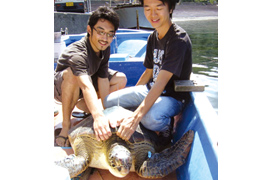The Mitsui & Co. Environment Fund
Introduction to Grant Projects
Sea Turtle Association of Japan
Preserving seagrass beds that are green sea turtle feeding sites
Activity grant
- Project Description
Green sea turtles, an endangered species on the Japanese Minsitry of the Environment's red list, were previously thought to live and breed on Yakushima and islands further south. However, information on turtles being stranded and caught as bycatch received from various areas of Japan has revealed that they migrate to summering grounds along the Sea of Japan coast of Japan's main islands. Recently seagrass beds along these coasts have been deteriorating, and there are fears for the impact on the turtles that use these plants as food. Therefore, this project aims to (1) research the distribution, seasonal variation, migration, and feeding habits of green sea turtles in Japan's coastal areas, (2) clarify the relationships between the plants being used by these turtles for food, (3) create materials to act as a foundation for turtle and seaweed conservation, and (4) recommend turtle and seaweed conservation policies. Specific activities include:
1) Identifying the seagrasses being eaten by turtles by measuring and analysing the stomach contents and fecal matter of turtles that have been caught accidentally, then tagging these turtles and releasing them back into the wild.
2) Using tracking devices to clarify turtle movements, as well as identifying sea grass beds that are being used as food and their corresponding sea turtle habitats. This will be done in collaboration with university student groups, local governments, aquariums, and others.
- Fields
- Preservation of biodiversity and ecosystem
- Grant year
- FY2005 Activity Grants
- Grant term
- 2 years and 3 months
January 2006 - March 2008
- Grant amount
- 4,278,500 yen
- Activity region
- Okinawa Prefecture and coastal areas of west Japan

Overview of the Organization

- Representative
- Naoki Kamezaki, Chairman
- Establishment
- 1990
- Establishment purpose
- Established to act as the central point of a network of organizations and individuals engaged in the conservation of sea turtles and the marine environment.
- Main areas of activity
- Hirakata, Osaka (HQ, public relations, information management); Cape Muroto, Kochi Prefecture (research); Kasasa, Kagoshima Prefecture (research); Kuroshima, Okinawa (research, education)
- Staff
- 7 full-time staff members, 5 part-time staff members, and 52 full members
- Annual operating budget
- 79.11 million yen in 2005, 58.94 million yen in 2006, 50.86 million yen in 2007
- WEB site
- http://www.umigame.org/
- Recent activities
- This year the Sea Turtle Association of Japan has shared information with associated individuals through 19 academic events and the publication of a journal, and has worked to nurture and develop research and conservation activities regarding sea turtles. Specific acheivements include an investigation into the number of times sea turtle species across Japan laid eggs through which a sudden decline over recent years was revealed, a project involving a unified marking system across the country for clarifying migration routes of loggerhead sea turtles after egg-laying, identifying where turtles were being washed ashore by building a stranding network relying on public participation, and publishing various books and materials. It is also working to increase environmental awareness among youth through lectures and the like.